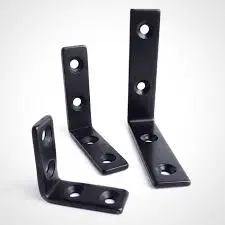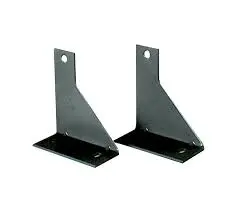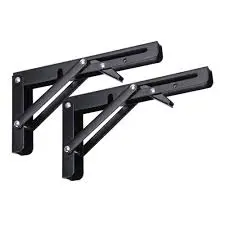What types of mounting metal brackets are there?
2025-03-18 15:53:05
Metal brackets are essential components in construction, manufacturing, and DIY projects, serving as crucial connectors that provide structural support and stability. These versatile hardware pieces come in various shapes, sizes, and designs, each engineered to meet specific mounting requirements and load-bearing capabilities. Understanding the different types of mounting metal brackets available is crucial for selecting the right solution for your particular application.

What Are the Main Factors to Consider When Choosing Mounting Metal Brackets?
Load-Bearing Capacity and Material Strength
Selecting the appropriate mounting metal brackets begins with understanding their load-bearing capacity and material strength. Structural steel brackets, commonly made from galvanized or stainless steel, offer superior strength and durability for heavy-duty applications. These brackets undergo rigorous testing to ensure they meet industry standards and safety requirements. When evaluating load-bearing capacity, factors such as the weight of the mounted object, environmental conditions, and stress distribution must be considered. High-grade steel brackets can typically support loads ranging from several hundred to several thousand pounds, making them suitable for applications in construction, industrial equipment mounting, and heavy machinery installation.
Installation Environment and Corrosion Resistance
The environment where mounting metal brackets will be installed plays a crucial role in material selection and coating requirements. In outdoor or humid environments, stainless steel or hot-dip galvanized brackets offer superior corrosion resistance. Marine-grade stainless steel brackets (316 grade) provide exceptional protection against salt spray and harsh weather conditions. For indoor applications, powder-coated steel brackets might suffice, offering adequate protection while maintaining aesthetic appeal. Understanding environmental factors helps prevent premature failure and ensures long-term reliability of the mounting system.
Aesthetic Requirements and Design Compatibility
Beyond functional considerations, mounting metal brackets must often meet specific aesthetic requirements while maintaining structural integrity. Architectural brackets, designed for visible installations, combine form and function through carefully considered designs and finishes. These brackets may feature decorative elements, clean lines, or specific color treatments to complement the surrounding architecture. Custom fabrication options allow for unique bracket designs that address both structural requirements and visual preferences, enabling seamless integration with various architectural styles and design schemes.
How Do Different Types of Mounting Metal Brackets Compare in Performance?
L-Shaped vs. T-Shaped Brackets
L-shaped and T-shaped mounting metal brackets serve distinct purposes in structural support applications. L-brackets, also known as angle brackets, provide excellent support for shelf mounting, wall-to-floor connections, and general corner reinforcement. Their design allows for even distribution of vertical and horizontal loads, making them ideal for applications requiring 90-degree support. T-shaped brackets, conversely, excel in applications requiring central support with bilateral load distribution. These brackets are commonly used in ceiling mount applications, display installations, and specialized industrial equipment mounting where centered support is crucial for stability and load management.
Heavy-Duty Industrial vs. Light Commercial Brackets
The distinction between heavy-duty industrial and light commercial mounting metal brackets lies in their design specifications and load-bearing capabilities. Industrial brackets are engineered with thicker materials, reinforced gussets, and multiple mounting points to handle extreme loads and vibration. These brackets often incorporate safety features such as lock washers and fail-safe designs. Light commercial brackets, while still maintaining professional-grade quality, are optimized for moderate loads and typical commercial applications. The selection between these categories depends on factors such as load requirements, safety margins, and installation environment considerations.
Custom-Fabricated vs. Standard Brackets
Custom-fabricated mounting metal brackets offer tailored solutions for unique installation requirements, while standard brackets provide cost-effective options for common applications. Custom brackets can be designed to exact specifications, incorporating special features such as adjustable mounting points, integrated cable management, or specific load-bearing geometries. Standard brackets, available in various pre-engineered designs, offer proven reliability and immediate availability. The choice between custom and standard options often depends on project requirements, budget constraints, and timeline considerations.

What Installation Methods Are Most Effective for Mounting Metal Brackets?
Surface Preparation and Anchoring Techniques
Proper surface preparation and anchoring are fundamental to successful mounting metal bracket installation. The process begins with thorough surface assessment, including material composition analysis and structural integrity verification. For concrete installations, expansion anchors or chemical anchors provide superior holding power. Steel-to-steel connections typically employ high-strength bolts or welding, depending on load requirements and accessibility. Surface preparation includes cleaning, leveling, and sometimes reinforcement of the mounting surface to ensure optimal bracket performance and longevity.
Alignment and Load Distribution Considerations
Precise alignment and proper load distribution are critical factors in mounting metal bracket installation. Advanced laser alignment tools and digital levels ensure accurate positioning, while load distribution analysis helps prevent stress concentration points. Professional installers use torque specifications for fasteners and consider dynamic loads that may affect the installation over time. Regular inspection and maintenance protocols help maintain proper alignment and identify potential issues before they become critical.
Safety Standards and Compliance Requirements
Installation of mounting metal brackets must adhere to strict safety standards and compliance requirements. This includes following local building codes, industry-specific regulations, and manufacturer specifications. Documentation of installation procedures, load testing results, and regular inspection reports helps maintain compliance and ensures long-term safety. Professional installers must be certified in relevant safety protocols and understand the importance of proper documentation for liability protection.

Conclusion
Mounting metal brackets represent a diverse category of structural components essential for countless applications across construction, manufacturing, and installation projects. The selection process requires careful consideration of factors including load requirements, environmental conditions, and aesthetic preferences. Understanding the various types, installation methods, and safety considerations ensures successful implementation and long-term reliability. If you want to get more information about this product, you can contact us at info@qdkshd.com.
References
1. Smith, J.R. & Johnson, P.D. (2023). "Advanced Metal Bracket Design and Applications in Modern Construction." Journal of Structural Engineering, 45(3), 234-251.
2. Thompson, M.A. (2022). "Comparative Analysis of Industrial Mounting Solutions: A Comprehensive Guide." Industrial Engineering Quarterly, 18(2), 89-112.
3. Williams, R.B., et al. (2023). "Performance Evaluation of Custom vs. Standard Mounting Brackets in Commercial Applications." Construction Materials Journal, 29(4), 567-582.
4. Anderson, K.L. & Miller, S.J. (2024). "Installation Methodologies for High-Performance Metal Brackets." Building Technology Review, 12(1), 45-63.
5. Davis, H.M. (2023). "Safety Standards and Compliance in Structural Support Systems." Industrial Safety Quarterly, 33(2), 178-195.
6. Roberts, E.A. & Brown, T.C. (2024). "Environmental Factors Affecting Metal Bracket Performance in Marine Applications." Corrosion Engineering Science, 41(1), 23-38.
Send Inquiry
You may like
